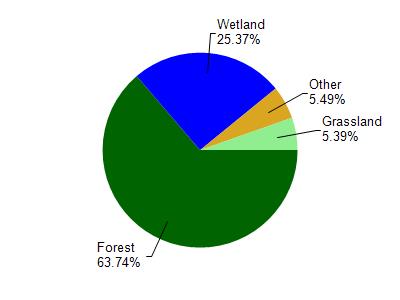Ashland
Yes
No
No
Fish and Aquatic Life
Overview
This Bad River tributary is considered a Class III trout fishery for brook, brown and rainbow trout, and is used by migratory species of trout and salmon from Lake Superior. The stream is considered a better brook trout stream above the confluence with Alder Creek than below. Beaver are frequently active in the upper reaches of the river, where migratory and nesting waterfowl are also found. This stream is subject to extreme flow variations, especially notable downstream from the confluence with Alder Creek where thermal levels can become lethal or near lethal for trout species. Most of the watershed is forested, where the potential exists for clearcutting and a hodgepodge of management approaches. Some agricultural clearing has occurred and several gravel pits also occur in the watershed. Several whitewater areas on the river feature waterfalls, most notably Potato River Falls, Foster Falls and Upson Falls. At the Iron/Ashland county line, the river crosses into the Bad River Indian Reservation. The river here tends to form large meanders in a broad valley, many becoming small oxbow ponds in the flood plain. We have very little information on this river.
During survey work conducted as part of the coastal wetlands evaluation, three rare species of macroinvertebrate were found in the Iron County portion of the stream, and one rare species was found in the Ashland County portion of the stream. Overall taxa richness was moderate (5-24 species) (Epstein 1997). Iron bacteria and aquatic plants were present at the survey site in Iron County, but not significant.
Turville-Heitz, Meg. 1999. Lake Superior Basin Water Quality Management Plan. Wisconsin Department of Natural Resources, Madison, WI.
Date 1999
Author Aquatic Biologist
General Condition
The Potato River was assessed during the 2018 listing cycle; new biological (macroinvertebrate Index of Biotic Integrity (IBI) scores) sample data were clearly below the 2018 WisCALM listing thresholds for the Fish and Aquatic Life use. This water was meeting this designated use and was not considered impaired.
Date 2017
Author Ashley Beranek
Condition
Wisconsin has over 84,000 miles of streams, 15,000 lakes and milllions of acres of wetlands. Assessing the condition of this vast amount of water is challenging. The state's water monitoring program uses a media-based, cross-program approach to analyze water condition. An updated monitoring strategy (2015-2020) is now available. Compliance with Clean Water Act fishable, swimmable standards are located in the Executive Summary of Water Condition in 2018. See also the 'monitoring and projects' tab.
Reports
Recommendations
Water Quality Planning
Water Quality Planning
Management Goals
Wisconsin's Water Quality Standards provide qualitative and quantitative goals for waters that are protective of Fishable, Swimmable conditions [Learn more]. Waters that do not meet water quality standards are considered impaired and restoration actions are planned and carried out until the water is once again fishable and swimmable
Management goals can include creation or implementation of a Total Maximum Daily Load analysis, a Nine Key Element Plan, or other restoration work, education and outreach and more. If specific recommendations exist for this water, they will be displayed below online.
Monitoring
Monitoring the condition of a river, stream, or lake includes gathering physical, chemical, biological, and habitat data. Comprehensive studies often gather all these parameters in great detail, while lighter assessment events will involve sampling physical, chemical and biological data such as macroinvertebrates. Aquatic macroinvertebrates and fish communities integrate watershed or catchment condition, providing great insight into overall ecosystem health. Chemical and habitat parameters tell researchers more about human induced problems including contaminated runoff, point source dischargers, or habitat issues that foster or limit the potential of aquatic communities to thrive in a given area. Wisconsin's Water Monitoring Strategy was recenty updated.
Grants and Management Projects
Monitoring Projects
| WBIC | Official Waterbody Name | Station ID | Station Name | Earliest Fieldwork Date | Latest Fieldwork Date | View Station | View Data |
|---|
| 2906200 | Potato River | 10043143 | Potato River near Vaughn Creek Confuence | | | Map | Data |
| 2906200 | Potato River | 10029292 | Potato River 10 M upstream of Potato River Rd | 10/8/2008 | 1/1/2015 | Map | Data |
| 2906200 | Potato River | 10043263 | Potato at Potato River Rd | 1/29/2013 | 1/29/2013 | Map | Data |
|

Watershed Characteristics
Potato River is located in the Lower Bad River watershed which is 123.92 mi². Land use in the watershed is primarily forest (63.80%), wetland (25.40%) and a mix of grassland (5.40%) and other uses (5.50%). This watershed has 317.28 stream miles, 11,923.85 lake acres and 17,289.12 wetland acres.
Nonpoint Source Characteristics
This watershed is ranked Not Ranked for runoff impacts on streams, Not Available for runoff impacts on lakes and Low for runoff impacts on groundwater and therefore has an overall rank of Low. This value can be used in ranking the watershed or individual waterbodies for grant funding under state and county programs.However, all waters are affected by diffuse pollutant sources regardless of initial water quality. Applications for specific runoff projects under state or county grant programs may be pursued. For more information, go to surface water program grants.